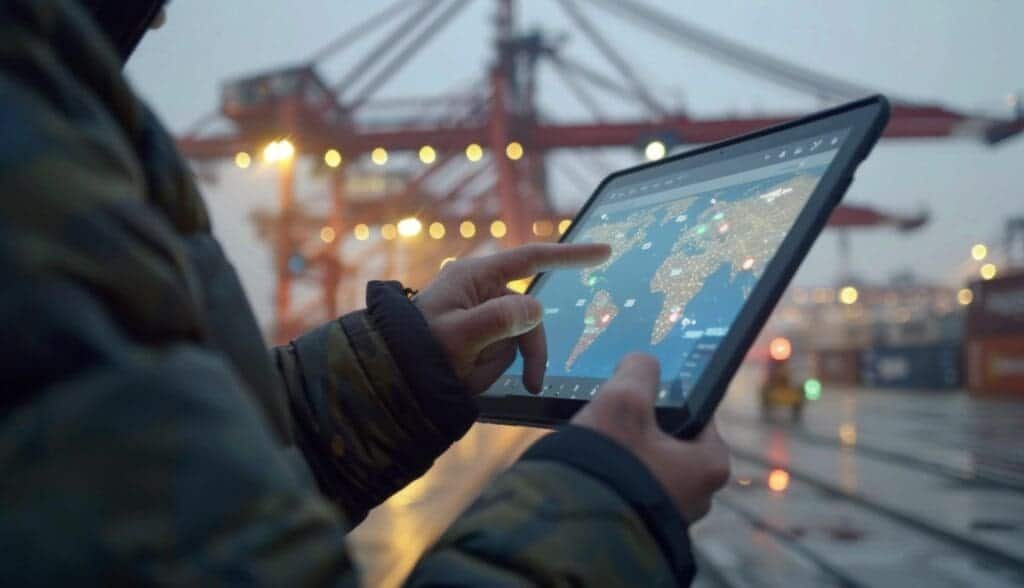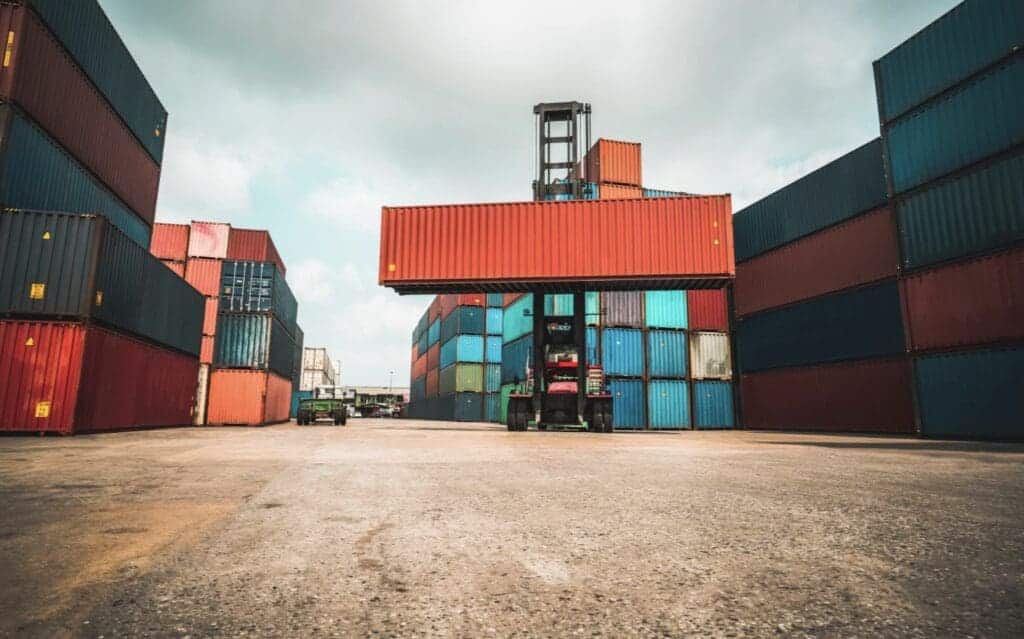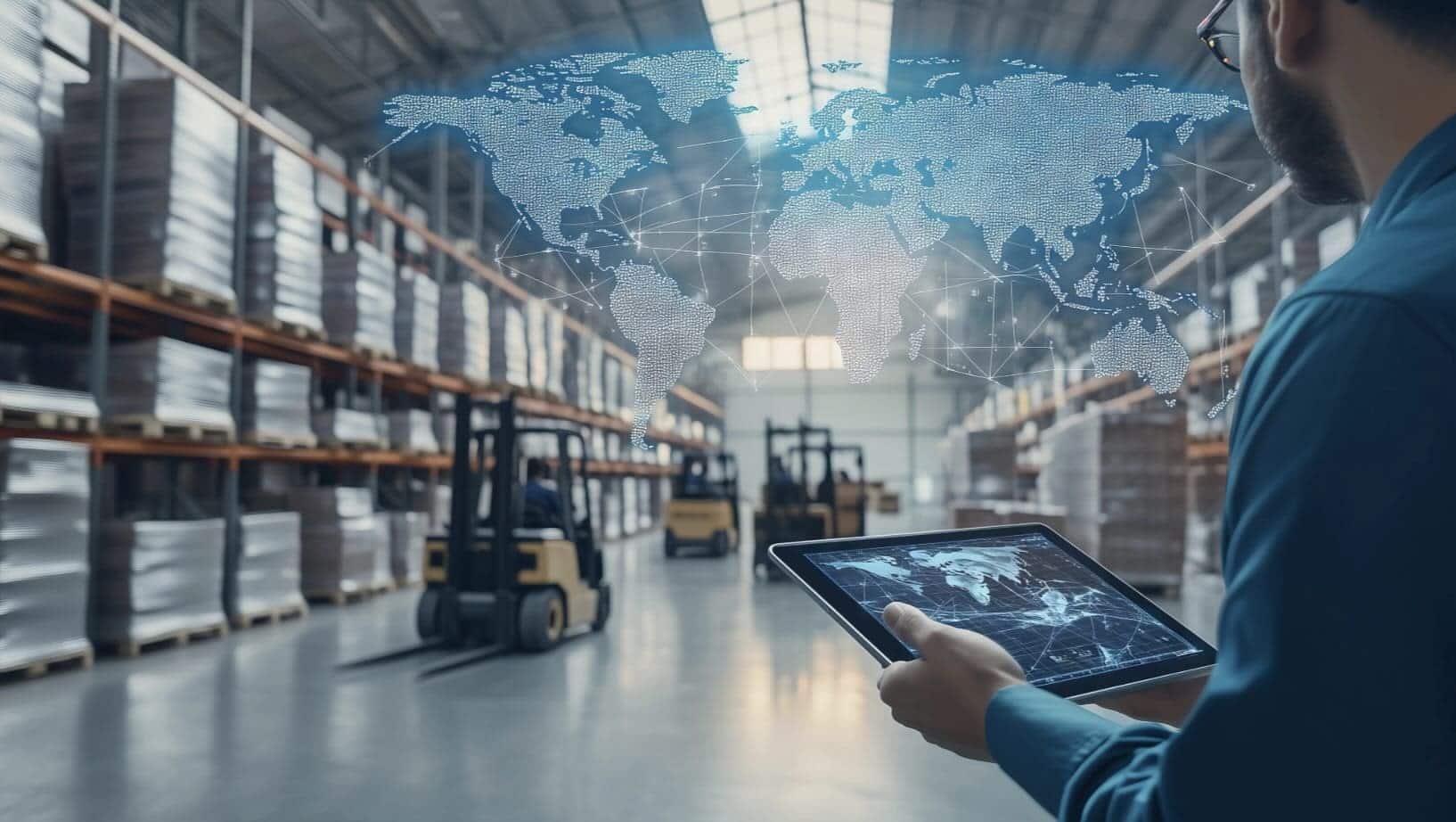In an age where global markets are continually shifting and consumer demands evolve at breakneck speeds, efficiently managing a supply chain has become more crucial than ever for businesses aiming to maintain their competitive edge.
This blog embarks on a journey through the multifaceted world of supply chain management, unraveling the pivotal role of technology in enhancing operational efficacies, examining the art of forging indomitable relationships with suppliers, and exploring strategies for injecting sustainability into every chain link. As we delve into the intricacies of inventory optimization and the imperative for crystal-clear visibility, we prepare to unearth the secrets to constructing an agile supply chain capable of weathering the storms of change in today’s dynamic economic landscape.
Table of Contents
- Adopting Technology in Supply Chain Management
- Building Robust Relationships with Suppliers
- Implementing Sustainable Practices
- Optimizing Inventory Management
- Enhancing Supply Chain Visibility
- Cultivating Agile Supply Chain Strategies
- Related Content
Adopting Technology in Supply Chain Management
Unleashing Efficiency: Technology’s Role in Revolutionizing Supply Chains
In a world where a mere second’s delay can mean a missed opportunity, the supply chain is the beating heart of a business that dictates success or failure. This is where technology sweeps in, flexing its digital muscles to redefine efficiency in supply chain systems across industries.
Gone are the days of rudimentary logistics and inventory management. The digital era introduces advanced algorithmic prowess with artificial intelligence (AI) and machine learning (ML) that forecast demands with uncanny accuracy. Predictive analytics is the new crystal ball, enabling business leaders to confidently make decisions, minimize waste, and ensure that products arrive precisely when and where needed.
Radio Frequency Identification (RFID) tags have transformed inventory tracking from a chore into a seamless operation. By scanning these tags, companies can instantly update their inventory levels, track goods through the supply chain in real time, and significantly reduce the likelihood of errors and loss.
Blockchain technology, though often heralded as the backbone of cryptocurrencies, has a pivotal role in crafting a transparent and secure supply chain. Each ‘block’ in the chain offers a tamper-evident record, making it easier to trace the origin of products and ensure that every link in the supply chain meets the compliance and ethical standards that consumers and regulators demand.
Internet of Things (IoT) devices add another layer of sophistication with granular data collection. Sensors embedded in products and shipping containers provide real-time location, temperature, and handling insights. This data can be a game-changer, especially for pharmaceuticals and food and beverage sectors, where storage conditions directly impact product integrity.
Things get even more exciting with Autonomous Vehicles (AVs) and drones starting to transport goods. Reducing human error, cutting costs, and speeding up delivery, these self-piloting machines are beginning to make a mark, particularly in the last mile of delivery, which is often the most complex and expensive leg of the journey.
The most transformative of all is the cloud-based supply chain management software. It unifies all this cutting-edge technology onto a single platform accessible anywhere, anytime. Real-time collaboration becomes a reality, streamlining communication between suppliers, distributors, and retailers, thus eliminating bottlenecks and ensuring a smoother flow of goods.
Revolutionizing the supply chain isn’t solely about speed; it’s about the power to see the big picture and the minutiae, the flexibility to adapt to market changes, and the resilience to withstand disruptions.
In a fiercely competitive market where efficiency is non-negotiable, integrating technology in supply chains is not just a perk—it’s paramount for survival and growth. The digital transformation of supply chains is not a future we are waiting for; it’s a dynamic reality reshaping the business landscape right now, creating opportunities for those ready to seize them.

Building Robust Relationships with Suppliers
Unlocking the Power of Supplier Relationships in Today’s Supply Chain Environment
In the dynamic and ever-evolving landscape of supply chain management, the crux of success often hinges on the strength and depth of supplier relationships. A robust supply chain is not merely a collection of companies doing business together but a finely-tuned ecosystem where every stakeholder plays a pivotal role in delivering value. Relationships with suppliers are not just beneficial—they are an absolute imperative.
At the core, these alliances boil down to mutual respect and understanding. Suppliers are more than just vendors; they are strategic partners vested in your growth. Establishing trust and open lines of communication fosters an environment primed for collaboration. Suppliers looped into your strategic vision can offer custom solutions that drive innovation and provide a competitive edge.
The benefits of solid supplier relationships resonate throughout the entire supply chain in several pivotal ways. First, they can lead to improved quality – a partner who aligns with your objectives will be vested in maintaining high standards. This benefit can cascade down the value chain, increasing customer satisfaction and loyalty.
Moreover, leveraging these relationships can yield significant cost efficiencies. Negotiating better terms and volume discounts is a straightforward advantage, but the savings often emerge from the joint efforts to optimize processes and eliminate waste. By working hand in hand, suppliers may reveal hidden inefficiencies and co-develop methods to streamline operations.
Risk mitigation is another facet where strong supplier ties shine. With the right partnership, supply chain disruptions, which can cost dearly in resources and reputation, can be preempted or swiftly managed. Reliable suppliers act as your first line of defense in an uncertain market, providing continuity and security through robust risk management practices.
Sustainability is an aspect where the positive influence of these relationships can’t be overstated. Today, the provenance of goods and the ethics behind their production are under intense consumer scrutiny. Collaborative suppliers are essential to ensuring sustainable practices across the supply chain, from reducing carbon footprints to ensuring ethically sourced materials.
Finally, strategic supplier alliances significantly enhance lead times and speed to market. In a fast-paced business world where the markets are immediate and trends are fleeting, agility is priceless. Suppliers attuned to your operational tempo can help shrink lead times and elevate responsiveness, allowing for quicker reactions to market demands.
Nurturing these supplier relationships goes beyond traditional networking; it involves a deliberate initiative to align goals, share information, and pursue mutual growth. It’s a dance of interdependence where every step and turn are orchestrated for collective performance, and the music is the rhythm of market demand.
In sum, as the supply chain continues to be reinvented through technological innovation and digital strategies, the centrality of human relationships remains undiminished. Supplier relationships are the bedrock upon which the supply chain stands, an anchor in a sea of change. Firms that understand and act on this will not only survive the currents of market upheaval but also steer towards the uncharted opportunities of tomorrow.
For an enterprise aiming to push the boundaries of what’s possible, investing in supplier relationships is not just a strategic move—it’s the cornerstone of a future-defined supply chain that thrives on collaboration, resilience, and the relentless pursuit of excellence.

Implementing Sustainable Practices
Maximizing Resource Efficiency in Tomorrow’s Supply Chain: The Competitive Edge
In a world where resource conservation is not just an environmental concern but a business imperative, companies are redefining sustainability as their strategic ace. Sustainable supply chain practices swiftly transition from being nice-to-have ethical choices to becoming crucial drivers of competitive advantage. As savvy business leaders, the focus now is on forging a supply chain that is as lean and green as it is mean on the market.
Operational cost savings are perhaps the most immediate benefit of sustainable practices. By prioritizing materials with less environmental impact and adopting eco-friendly processes, businesses are seeing a significant reduction in waste production and energy usage. This saves on costs and appeals to the growing market segment of eco-conscious consumers. In essence, going green means more greenbacks saved and earned.
However, the advantages of sustainable supply chains are not limited to fiscal savings. The modern consumer market is highly aware and socially responsible. A transparent and sustainable supply chain polishes brand image. It becomes a powerful tool in reputation management, necessary for brand loyalty and customer retention in an era where corporate social responsibility weighs heavily on purchasing decisions.
Moreover, regulatory compliance regarding sustainability is no shallow pond to wade through. The proactive adoption of sustainable practices puts companies ahead of the curve, effectively future-proofing them against looming regulations that could disrupt unprepared competitors. This strategic forward-thinking solidifies a company’s position as a leader, not a follower, in industry standards.
Investing in renewable and recyclable materials can pay dividends, quite literally. Sustainable procurement requires scrutinizing the supply chain, which often uncovers inefficiencies and opens new opportunities for innovation. By adopting the cradle-to-cradle model, companies gain the double advantage of product circularity and brand distinction.
Dive deep into the logistics side of operations, and we find that optimized route planning and fuel-efficient transportation modes do more than reduce carbon footprints—they slice through excessive shipping costs. Advanced logistical planning tools that favor sustainability are setting industry benchmarks. Supply chains that lag in adopting these eco-efficient methodologies will likely find themselves outpaced by eco-innovators who view logistics as a necessary overhead and a competitive variable to be optimized.
Partnerships within the supply chain can also blossom into profitable ecosystems. Transparent collaboration results in shared sustainability goals and innovations, bolstering individual companies and the industries they inhabit. These alliances can pave the way for shared investments in green technology, reducing the financial burden on individual companies while multiplying the positive impact on the environment.
Lastly, let’s address risk management. Sustainable supply chains are inherently more resilient. For example, companies that commit to sourcing from various geographically dispersed, responsible suppliers create buffers against localized disruptions. Given the increasing unpredictability of global events, such preparedness isn’t just bright—it’s a necessity for business continuity.
An intelligible transition toward sustainability harnesses far-reaching benefits. From cost savings to enhanced corporate image, from compliance with future regulations to cutting-edge innovation, sustainability in the supply chain is not a mere trend. It is a solid strategy for companies serious about maintaining a competitive advantage in a business sphere that is becoming inexorably conscious of its environmental and social footprint. As champions of this cause, businesses are positioning themselves for profitability and leading the charge in the stewardship of our planet’s resources—a twin win to aim for.

Optimizing Inventory Management
Maximizing warehouse space cannot be overlooked in the pursuit of streamlining inventory. Crafting an efficient layout is paramount for swift, error-free picking and packing. Let’s explore the strategies that transform storage spaces from chaotic to coherent, aligning with today’s dynamic supply chain demands.
First on the agenda is a meticulously designed warehouse layout.
This strategy begins with examining current space usage, identifying waste areas and potential improvement. Bright layout designs enforce a systematic flow of goods, reducing travel time and avoiding bottlenecks.
Organizing inventory by velocity is a game-changer.
By keeping high-turnover items accessible, businesses can minimize the time and effort expended in retrieval. This velocity-based placement dovetails with a just-in-time inventory approach, keeping stock levels lean and avoiding overstocking.
The embrace of vertical space can revolutionize square footage efficacy.
By integrating taller storage units and investing in the equipment to access these heights, warehouses can expand upwards rather than outwards, a boon for facilities with limited footprint yet boundless vertical potential.
In tandem with the vertical expansion, choosing the proper storage systems is a must.
Adjustable shelving, modular drawer systems, and stackable bins offer the flexibility to adapt to changing inventory sizes, types, and quantities, creating a space that can evolve with shifting market needs.
Eliminating unnecessary inventory is a powerful technique.
A thorough analysis, coupled with vigorous inventory auditing, illuminates underperforming stock. Through strategic clearance and avoidance of surplus, valuable real estate is reclaimed for items that contribute positively to the bottom line.
Finally, cross-docking is an ace up the sleeve for inventory velocity.
By moving incoming goods directly to outgoing transport with minimal storage time, businesses can significantly reduce inventory handling and storage requirements. This tactic aligns perfectly with sectors characterized by perishables or fast fashion.
While inventory streamlining strategies are many and varied, the most effective approaches are based on a confluence of design optimization, smart stocking, and waste elimination.
Leveraging these strategies smartly can position a warehouse for seamless operations and set the stage for a more cohesive, responsive supply chain. Efficient inventory management doesn’t just clear the clutter—it unlocks the door to a sleeker, more agile operation ready to meet the consumer’s rising demands head-on.

Enhancing Supply Chain Visibility
How Enhanced Visibility Advances Customer Relations and Service in Supply Chain Operations
In the dynamic world of supply chains, visibility has transcended traditional tracking and monitoring to become a pivotal element in customer relations and service. Enhanced visibility doesn’t just track products; it fosters trust, communication, and satisfaction, ensuring customers remain informed and reassured throughout their buying journey.
Real-time tracking systems now provide customers instant access to their order status, fostering transparency and diminishing uncertainty. This capability puts power into the customers’ hands, creating a sense of control and partnership in logistics. When customers are kept in the loop regarding their shipments, it reduces the volume of customer service inquiries and improves overall satisfaction.
Customization is another benefit of heightened visibility in supply chains—businesses can now offer personalized experiences. With a comprehensive view of inventory levels, transportation routes, and delivery times, companies can tailor their services to meet specific customer needs and expectations. This bespoke approach breeds loyalty and potentially increases lifetime value.
Moreover, the implementation of effective visibility measures can significantly enhance after-sales service. The ability to quickly identify and resolve issues with orders not only salvages individual sales but also upholds the brand’s reputation. Fast and efficient rectification of problems sends a resounding message about a brand’s dedication to customer satisfaction.
The escalation of supply chain visibility also introduces a proactive component to customer service. Instead of reacting to issues as they arise, companies can anticipate disruptions, predict delays, and inform customers of potential problems. Such preemptive communication exemplifies an organization’s commitment and capability to manage their end-to-end operations competently.
Innovative visibility tools are reshaping expectations and setting new standards for service delivery in the supply chain. The link between a transparent, responsive supply chain and customer satisfaction has never been stronger. Today’s consumers demand quick and reliable delivery and a transparent journey from warehouse to doorstep.
Investing in enhanced visibility is not merely about operational oversight but also about elevating customer relations and service to drive growth and success in the modern marketplace.
As businesses strive to stay ahead, embracing enhanced visibility is not just advisable but imperative. It cements customers’ trust, enhances operations’ efficiency, and underpins the agility needed to thrive in today’s fast-paced, customer-centric environment.
Stellar customer service and robust relationships facilitated by transparent, high-visibility supply chains are no longer optional luxuries—they’re defining pillars of excellence in the contemporary business landscape.

Cultivating Agile Supply Chain Strategies
In the bustling world of logistics, the final leg of a product’s journey, the last-mile delivery, has undergone a seismic shift. Now, agility in this segment isn’t just a preference—it’s an absolute must. A nimble approach to last-mile delivery separates thriving businesses from those struggling to keep pace. Why is this? Because in today’s fast-moving market landscape, customers are not just expecting speed; they’re demanding precision and flexibility in their delivery options.
The proliferation of e-commerce has catapulted customer expectations to astonishing heights. Consumers crave the convenience of same-day deliveries, precise time slots, and the ability to adjust delivery details. Meeting these demands requires an innovative mindset and a supply chain that’s not merely reactive but anticipates and adapts to real-time changes.
Adaptable Routing—Intelligent routing systems are a linchpin in this agile strategy. Unlike static routes carved in stone, dynamic routing allows for adjustments in response to traffic conditions, weather, and unexpected delays. This fluidity ensures that deliveries remain on schedule and customer promises are met, bolstering satisfaction and trust.
From a business standpoint, adaptable routing isn’t just about keeping customers happy—it’s a cost-saving mechanism that reduces fuel consumption, optimizes driver hours, and minimizes the carbon footprint.
Personalization at the Doorstep – Beyond the mechanics of delivery, personalized options have become a hallmark of an agile last-mile strategy. Custom delivery instructions, secure location drop-offs, and the ability to reroute packages to local collection points afford a level of personalization that today’s consumers find irresistible.
Fulfillment Models That Flex – Another core component of modern last-mile agility is the diversification of fulfillment models. Local mini-warehouses, pop-up distribution centers, and partnerships with retail outlets for in-store pickups allow businesses to position inventory closer to customers, slashing delivery times and costs.
Crowdsourced Delivery Networks—Technology platforms underpin freelance drivers and local couriers, contributing to a more flexible and scalable delivery workforce. These crowdsourced networks provide the elasticity required to handle volume spikes, such as those seen during holiday periods, without needing a fixed investment in fleets or full-time personnel.
Environmental Considerations—Sustainability is not just a nod to eco-friendliness; it’s a strategic advantage. Innovations like electric delivery vehicles reduce emissions and resonate with environmentally conscious consumers while also preparing businesses for impending regulations aimed at curbing pollution in urban areas.
The last-mile delivery conundrum, with challenges and opportunities, cannot be overlooked. Businesses poised to survive and thrive are willing to harness agility in their supply chain strategy. With the rise of technology and shifting consumer trends, last-mile delivery has never been more pivotal.
The ever-changing tapestry of supply chain management demands constant vigilance and an indefatigable quest for improvement. As we’ve journeyed through the various elements that coalesce to form an effective supply chain strategy, it becomes evident that the convergence of technological innovation, robust supplier relationships, sustainable practices, optimized inventory, enhanced transparency, and agility forms the cornerstone of supply chain excellence.
By embracing these principles, companies can navigate the complexities of the global market with confidence and dexterity, ensuring longevity and success in the face of the relentless tides of change.
If you are interested in seeing how Mondoro can help you with your supply chain – we would love to talk to you about how we can help you and be part of your global supply chain.
Find out more about how Mondoro can help you create, develop, and manufacture excellent home decor and home furniture products – don’t hesitate to contact me, Anita. Check out my email by clicking here or become a part of our community and join our newsletter by clicking here.
Mondoro gives out a FREE Lookbook to anyone interested. You can receive a copy of our latest Lookbook by clicking here.
Listen to our Podcast called Global Trade Gal. You can find it on all major podcast platforms. Try out to listen to one of our podcasts by clicking here.
Subscribe to our Mondoro Company Limited YouTube Channel with great videos and information by clicking here.
Related Content
AI And The Supply Chain, 15 Ways Explored
AI or Artificial Intelligence will change the global supply chain in many ways. Everything from refining forecasting capabilities to helping select suppliers to automatization of the entire global supply chain workflow. Read on as we explore how AI will help revolutionize the global supply chain.
You can learn more by reading AI And The Supply Chain, 15 Ways Explored by clicking here.
Aligning Your Supply Chain With Your Business Strategies
The Supply chain and the business strategies are some of the most important strategies a business can have. A business should look to align both its supply chain and business strategy. To do, there are several steps that they can take to ensure this happens. Read on as we explore the steps a company can take to align its supply chain and business strategies.
By clicking here, you can learn more by reading our blog, Aligning Your Supply Chain With Your Business Strategies.
Analysis Of Three Key Flows In Supply Chain Management
The three critical flows in supply chain management are material or product, information flow, and financial flow. All of these flows in the supply chain are essential, and they help to ensure the smooth running and operation of the supply chain.
You can learn more by reading our blog, Analysis Of Three Key Flows In Supply Chain Management by clicking here.

